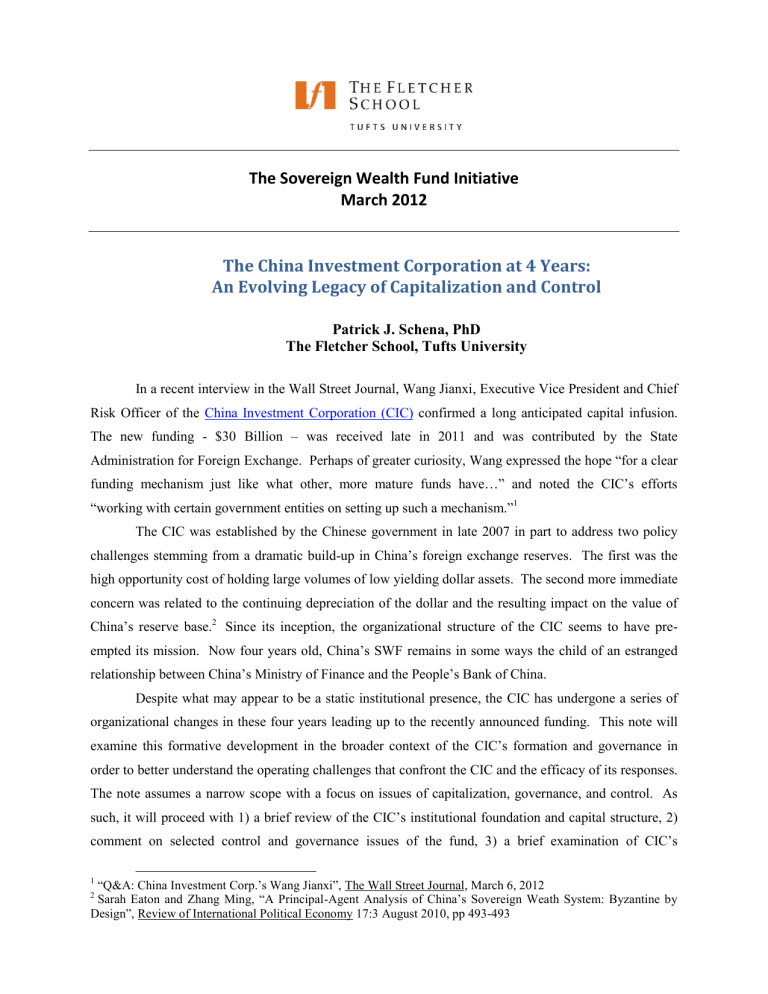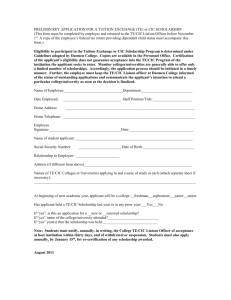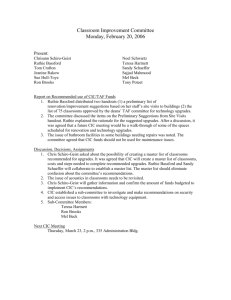The Sovereign Wealth Fund Initiative March 2012

The Sovereign Wealth Fund Initiative
March 2012
The China Investment Corporation at 4 Years:
An Evolving Legacy of Capitalization and Control
Patrick J. Schena, PhD
The Fletcher School, Tufts University
In a recent interview in the Wall Street Journal, Wang Jianxi, Executive Vice President and Chief
Risk Officer of the China Investment Corporation (CIC) confirmed a long anticipated capital infusion.
The new funding - $30 Billion – was received late in 2011 and was contributed by the State
Administration for Foreign Exchange. Perhaps of greater curiosity, Wang expressed the hope “for a clear funding mechanism just like what other, more mature funds have…” and noted the CIC’s efforts
“working with certain government entities on setting up such a mechanism.” 1
The CIC was established by the Chinese government in late 2007 in part to address two policy challenges stemming from a dramatic build-up in China’s foreign exchange reserves. The first was the high opportunity cost of holding large volumes of low yielding dollar assets. The second more immediate concern was related to the continuing depreciation of the dollar and the resulting impact on the value of
China’s reserve base.
2
Since its inception, the organizational structure of the CIC seems to have preempted its mission. Now four years old, China’s SWF remains in some ways the child of an estranged relationship between China’s Ministry of Finance and the People’s Bank of China.
Despite what may appear to be a static institutional presence, the CIC has undergone a series of organizational changes in these four years leading up to the recently announced funding. This note will examine this formative development in the broader context of the CIC’s formation and governance in order to better understand the operating challenges that confront the CIC and the efficacy of its responses.
The note assumes a narrow scope with a focus on issues of capitalization, governance, and control. As such, it will proceed with 1) a brief review of the CIC’s institutional foundation and capital structure, 2) comment on selected control and governance issues of the fund, 3) a brief examination of CIC’s
1
“Q&A: China Investment Corp.’s Wang Jianxi”, The Wall Street Journal, March 6, 2012
2
Sarah Eaton and Zhang Ming, “A Principal-Agent Analysis of China’s Sovereign Weath System: Byzantine by
Design”, Review of International Political Economy 17:3 August 2010, pp 493-493
relationship with China’s State Administration for Foreign Exchange, and 4) a analysis of several key issues which impact the optimization of the management of China’s foreign reserves.
Troubled Birth?: Capitalization “with Chinese Characteristics”
The genesis of the CIC, as noted, was rooted in attempts to resolve scale and cost issues posed by the rapid expansion of China’s reserve base. By the end of 2006, the idea of a separate investment vehicle had garnered support within China’s political leadership. However, considerable disagreement remained as to the precise constitution, management, and capitalization of the entity. Then as now the primary rivalry pitted China’s Ministry of Finance (MoF) and the People’s Bank of China (PBoC),
China’s central bank.
Under the Law on People’s Bank of China (1995), the PBoC owns, administers, and manages
China’s foreign reserves. In practice, the PBoC has delegated reserve management to a subsidiary department, the State Administration for Foreign Exchange (SAFE). SAFE functions equivalently to a vice-ministry agency and is headed by a deputy governor of the PoBC.
3
For its part the MoF argued its case on the basis of international best practice, pointing to the cases of Singapore and Japan.
4
The leadership’s election of the MoF model has left a legacy of governance and control issues which in part motivates this note.
To give effect to this decision and establish the CIC, the government designed a complex transaction, outlined in Figure I, which was structured to both capitalize the CIC, while simultaneously executing a monetary sterilization operation. Under this arrangement, the MoF issued a RMB 1.55T note program through the Agricultural Bank of China and employed the proceeds to acquire USD 200B is foreign exchange assets, which it then used to initially capitalize the CIC.
3
Hu Yu-Wei , "Management of China’s Foreign Exchange Reserves: A Case Study on the State Administration of
Foreign Exchange (SAFE)", Economic Papers 421, July 2010. Prepared by the Staff of the Directorate-General for
Economic and Financial Affairs, European Commission
4
See Pekkanen, Saadia M. and Kellee S. Tsai, “The Politics of Ambiguity in Asia’s Sovereign Wealth Funds”,
Business and Politics, Vol 13, Issue 2, 2011, p 22 and Eaton and Ming, p 493
The program drained liquidity from China’s monetary base and transferred USD 200B in reserves to the new entity to be managed so as to diversify China’s dollar exposure at a higher return on invested assets. The new vehicle was organized as a wholly state-owned company incorporated under China's
Company Law.
5
Importantly, it was established with ministerial rank and has since reported directly to
China’s State Council. That is, despite the MoF’s role in the CIC’s initial capitalization, both organizations ostensibly function as peers (see Figure II). This relationship notwithstanding, the CIC’s balance sheet since 2008 reflects the USD 200B as “registered capital” 6
, i.e. as equity.
Interestingly among its first actions, certainly counting among its inaugural investments, the CIC purchased various domestic banking assets from the PBoC. Specifically, the CIC acquired Central Huijin
Investment (Huijin) and China Jianyin Investment Company from the PBoC for USD 67 million
7
(see again Figure II). With this acquisition the CIC became the parent of two investment companies and the beneficial owner of China’s stakes in Blackstone and Morgan Stanley. However, it also became the owner of various state holdings in China’s domestic banking sector, making it the largest shareholder of the China Construction Bank, the Bank of China, the Industrial and Commercial Bank of China, and
China Everbright Bank and giving it direct economic control over these institutions.
8
5
Eiichi Sekine, "The Governance of China Investment Corporation on Its Way to Becoming a Sophisticated
6
Institutional Investor", Nomura Journal of Capital Markets, Winter 2011 Vol.2 No.3
See CIC annual reports and in particular http://www.chinainv.cn/cicen/include/resources/CIC_2008_annualreport_en.pdf
7
Huijin was established in 2003 as part of China’s overall approach to banking reform. Its mandate was to support the recapitalization of China’s state owned banks and to facilitate their initial public offerings. In this capacity,
Huijin, injected USD 45B in foreign exchange reserves in Bank of China and the China Construction Bank, receiving equity in return. See Eaton and Ming, p 495.
8
See Walter, Carl E. and Fraser J. T. Howie, Red Capitalism: The Fragile Financial Foundation of China’s
Extraordinary Rise (Singapore: John Wiley & Sons (Asia)Pte. Ltd., 2011, p 135
Governance and Control
Despite the formal central government framework, it was apparent at the outset that operating control of the CIC would be biased in favor of the MoF. Established as a state-owned enterprise, the CIC is required under China's Company Law to have a board of directors and a board of supervisors appointed by China's State Council. The role of the Board of Directors is to define the CIC's development strategy, management policies, and investment objectives.
9
The founding Chairman of the CIC, Lou Jiwei, a former Vice Minister of Finance, was appointed by Premier Wen Jiabao. Other directors are also appointed by the State Council. Similarly, the chairman of the Board of Supervisors is appointed by the State Council from among the board's members. There are 11 directors, five of whom come from the State Development and Reform Commission, the Ministry of Finance, the Ministry of Commerce, the People's Bank of China, and the State Administration of
Foreign Exchange (SAFE). Beside Lou, the vice chairman (president and chief investment officer) comes from the China Securities Regulatory Commission (CSRC) and the executive vice president (chief operating officer) also comes from the Ministry of Finance.
10
Organizationally, Huijin with its concentrated holdings in domestic financial assets sits as a wholly-owned subsidiary of the CIC. As China’s financial system has developed and its major banks have expanded, the market value of the domestic holdings has more than doubled. At the end of 2011, an attempt was made to further segregate these domestic financial holdings from the CIC’s foreign assets with the establishment of CIC International. According to Wang Jianxi, this was the motivated by
“hurdles” on overseas investment resulting from the size of Hujin’s domestic bank investment.
11
In fact as reported, both units will continue under the CIC’s control and will be run independently of each other.
12
Interestingly, this reorganization has prompted considerable debate on the eventual disposition of
Huijin (specifically its being spun out of CIC and/or possibly returned to PBoC
13 ), the role of China’s sovereign wealth fund in supporting financial system reform, and the evolving institutional structure of reserve management in China.
Sibling Rivalry
Though certainly the best known, the CIC is not the only state investment vehicle operating in
China. Among others might be numbered the China Development Bank and the National Council for
Social Security Fund (NSSF). The PBoB, through SAFE, also functions as an investor on a massive, global scale, primarily known for its management China’s reserve holdings in US Treasury securities. By
9
Sekine
10
Ibid.
11
Q&A: China Investment Corp’s Wang Jianxi
12
Ibid.
13
For example, see Walter and Howie, p 138
virtue of the political dynamics involved in the CIC’s establishment, including the transfer of Huijin to the CIC, it would be reasonable to assume a degree of rivalry between these two institutions. Nonetheless, with the formation of CIC, there appeared to exist grounds for a natural delegation of investment mandates: SAFE to invest China’s overall foreign exchange reserve position; CIC to invest excess reserves.
The evolving realty is far more nuanced. While the preponderance of China’s reserves sit in US government securities, SAFE has been nothing of an exclusively passive investor. SAFE established a
Hongkong subsidiary as early as 1997 and, through that entity, has invested actively in risky assets. In fact there is evidence that the pace of such investment accelerated after the establishment of the CIC.
Based upon estimates derived from US Treasury data, Brad Setser has argued that SAFE, acting through its Hong Kong subsidiary, invested between US $150 and $200 billion in US, European and Australian equities during 2007 to 2008. These have included minority positions in three Australian banks acquired in December 2007 for USD 185M, a 1.6 per cent position in TOTAL SA, a large oil and natural gas provider, added in April 2008 for USD 2.85B, and minority holdings in over 40 British listed companies, including British Petroleum, Barclays, HBOS Plc and Royal Bank of Scotland, acquired between January and July 2008.
14
The effects of such inter-agency competition on both the governance and efficiency of reserve management raise questions about the politicization of China’s global macro-economic strategy and the role of China’s sovereign funds in that context.
15
This broad question is beyond the immediate scope of this note. Of relevance here, however, is 1) the impact of CIC-SAFE rivalry on their respective investment strategies and asset allocation decisions and 2) the evolving relationship between the agencies as the CIC’s role expands and additional reserves are transferred to it.
Organized for Optimizing Reserve Management?
Since its formation in September 2007, the CIC has expanded its professional footprint by establishing, then further refining its investment procedures, risk management systems, and middle and back office operations. This has included the design of institutional controls on internal processes and systems, including the streamlining and strengthening the investment approval process, creating an investment operations department to strengthen coordination among different units along the investment decision and execution process, and developing the CIC's proprietary trading infrastructure.
16
Thus, institutionally the CIC continues to evolve as an institutional investor poised for scale on a global basis.
14
Eaton and Ming, p 498. See also Brad Setser, "SAFE seems to have started buying US equities in the spring of
2007, and didn’t stop until July 2008", March 15, 2009, accessed at http://blogs.cfr.org/setser/2009/03/15/safeseems-to-have-started-buying-us-equities-in-the-spring-of-2007-and-didnt-stop-until-july-2008/
15
In fact, Eaton and Ming view this competition as a “tournament” through which the Chinese leadership exercises governance over the funds.
16
Sekine, “Governance”
Such organizational advancements notwithstanding, several institutional challenges –spurred by interagency competition - remain, which leave legitimate questions as to the efficacy of the overall investment process for Chinese reserve management.
In the case of CIC, whose mandate includes asset and currency diversification across the risk spectrum, pressures created by an active SAFE strategy to invest in risky assets, may have contributed to an aggressive investment posture in the first years of its founding. As noted, the CIC’s initial investments included acquisition of Huijin. Thereafter, the CIC also invested a total USD 60B to recapitalize the
Agricultural Bank of China and the China Development Bank. Thus a substantial portion of its original capital has been committed domestically to support the stability of China’s banking sector. However, estimates suggest that much of the balance of the initial capitalization was dispersed by 2010, as reports began to surface that the CIC was pursuing additional funding. The efficiency of an investment approach which fosters inter-agency competition will eventually be judged both on the basis of performance returns and contribution to the overall allocation balance and risk profile of the reserve portfolio. More strategically over time, it must also be part of a broader review and analysis of China’s reserve management policy. How then to define the CIC’s functional role and the continuing source of its funding/capitalization in future?
As Wang Jianxi noted in our opening paragraph, if the CIC’s role is to continue to expand, the
State Council must resolve its on-going source of funding. Several approaches to this issue have circulated, including a return to the issuance of special government bonds, a direct equity investment by the PBoC/SAFE in the CIC, or even SAFE out-sourcing reserve management to CIC.
17
There is a degree of ambiguity as to the precise constitution of the second, i.e. the most recent – USD 30B – infusion.
Some reports have suggested the funding represents a shareholding by the PBoC in the CIC and so may have later governance consequences to CIC.
18
Additionally, it may be part of the broader solution to the
CIC’s funding dilemma suggested by Wang as currently under review. In either case, definition of the functional roles of both the CIC and SAFE and a resolution to the systematic transition of excess reserves for active management, at present seemingly hostage to China’s bureaucratic vagaries, must proceed in order to enhance the ability of both organizations to function effectively.
17
Eiichi Sekine, "Moves by China to Improve How it Manages Its Foreign Exchange Reserves", Nomura Journal of
Capital Markets, Autmun 2011 Vol.3 No.2
18
See “CIC to Restructure”, ZED-ALERT, October 25, 20122, accessed via http://www.zed-alert.com.hk/zedalert/cic-to-restructure
Toward Adolescence
Despite Western media images of a monolithic entity well-placed within a coherent national strategic framework to exploit China’s financial strength 19
, the CIC’s reality is rather more complex.
Barely a toddler by the yardstick of longer established funds, the CIC’s operations remain wrapped in an evolving legacy of capitalization and control. The new capital infusion and Wang’s suggestion of a systematic approach to funding imply an orderly process of institutional change, which should strengthen the independence and professionalization of the CIC’s investment and risk management functions.
Importantly, a defined funding mechanism in particular will enhance the CIC’s ability to manage liquidity and to deploy assets more efficiently and in a more balance fashion. As it matures into adolescence, the
CIC must be prepared to face and resolve the internal challenges that have defined it early existence, while engaging in a continuous process of institutional self-examination and, as required, re-invention if it is to distinguish itself as a premier global investor. Its success will require both technical expertise, as well as a substantial dose of the political acumen that has served it to date.
19
Jean-Marc Blanchard, “China’s Grand Strategy and Money Muscle: The Potentialities and Pratfalls of China’s
Sovereign Wealth Fund and Renminbi Policies”, The Chinese Journal of International Politics, Vol. 4, 2011, pp 32-
33. See especially note 9.









